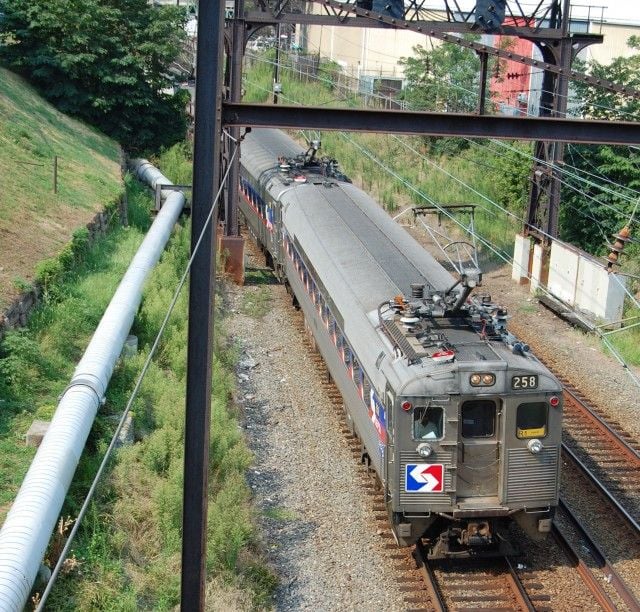Philadelphia’s regional transit agency last week announced the details of a July 1 fare hike and the implementation of a New Payment Technology system, which Next City covered last month. The move is expected to net the Southeastern Pennsylvania Transportation Authority, or SEPTA, about $25 million.
The cost increases are part of SEPTA’s plan to bump fares every three years. Tokens will rise in cost from $1.55 to $1.80, and cash payments will rise from $2 to $2.25. While Richard Burnfield, SEPTA’s chief financial officer, assured reporters at a Thursday press conference that “in 2014 tokens will be retired,” he also said that the adoption of New Payment Technology will have no effect on the base price of an intracity ride. “Fares will continue to be priced at $1.80,” he said. (That is, until 2016, when the next fare hike is scheduled.)
Despite the increase, Philadelphians will get off lightly compared to riders on sister transit agencies. According to a table presented at the press conference, a base non-cash payment ride in New York or Pittsburgh costs $2.50, while one in Chicago costs $2.25 and Boston $2.
But most SEPTA riders do not fumble for exact change for tokens, instead relying on weekly and monthly TransPasses. The former will increase from $22.00 to $24.50, the latter from $83 to $92. Regional rail riders, who tend to commute from the suburbs or outlying city neighborhoods, will also experience fare hikes, allowing for exceptions.
And here’s where things get complicated: SEPTA’s regional rail system is currently divided into five zones. The farther you have to travel to get to Center City, the more your fare costs. The fifth and outermost zone will be eliminated in the re-organization scheme and moved into Zone 4 (where their fares will remain static at $53 a week), while half of Zone 4’s current ridership will remain within its fold and the other half moved into Zone 3. “We took the smallest zone [Zone 4] and split it down the middle, based on air miles to Philadelphia,” Burnfield said.
This means that the riders absorbed into Zone 3, which includes stops in relatively affluent areas like Croydon, Warminster and Berwyn, will pay less than they do now. Current Zone 4 riders pay $47.45 for a Weekly TrailPass, which under the new fare model will cost $44.00 a week (amounting to savings of more than $150 a year).
But some regional rail riders, who could actually use an extra $150 a year, won’t be so lucky. A $22 TransPass is cheaper than any of the TrailPasses and can be used on the Airport Line, which runs to Philadelphia International Airport. This allows airport workers to access their jobs in a relatively affordable way and also lets riders from lower-income Southwest Philadelphia, who use Eastwick Station, to commute downtown cheaply and quickly. This service is especially important because this regional rail stop is the only rail option to downtown in the area.
But as the Philadelphia Inquirer reported Friday:
Bus and subway passes will no longer be valid for weekday Regional Rail travel, which could more than double the transportation costs for Philadelphia International Airport employees who take the train to and from work. Currently, those Transpasses are valid for airport trains.
SEPTA isn’t blind to troubles of lower-income airport workers, who have been politically active this year and in February won an expansion of Philadelphia’s living wage law to cover their (often minimum wage) jobs. “We’re in discussions with the city and airport officials to come up with a solution so that any increase to workers would be more in line with other increases we’ve proposed,” said Andrew Busch, a SEPTA press officer. “It was never the intention to have them start paying top-zone fares, and they definitely will not have to start paying Zone 4 fares as of July 1. It’s just unclear at this time what type of pass it will be, the price and some other details.”
Eastwick is not likely to be included in the solution. As of July 1, commuters from this station will have to use TrailPasses, priced at $27.25 a week, rather than the $22.00 they currently pay for a TransPass ($24.50 under the new fare structure). That’s around $250 more annually than what they pay now. As social worker and journalist Jeff Deeney tweeted, “Eastwick commute time probably doubles taking the trolley/bus & the increase to zone 1 is huge money for working class.”
But changes to the structure of the “Center City Hub” could mean huge savings for a different group of urban commuters. The inner circle fare zone for regional rail currently includes seven stations: The five that are the most common commuter destinations — Suburban, 30th Street, University City, Temple and Market East stations — and two outliers, North Philadelphia and North Broad stations. These last two are being moved out of the Central Hub, because few people commute to these low-income neighborhoods and the stations are mostly used for what Burnfield called “reverse commuting”, or riders leaving the neighborhood to work in the suburbs. (Only 6 percent of the combined ridership at the North Philly and North Broad Street stations are headed downtown — that’s 23 riders.)
Riders “reverse commuting” from the North Broad and North Philadelphia stops will receive substantial savings by their absorption into Zone 1 combined with the option of a weekly Cross-County Pass, priced at $29. The 96 percent of North Philly and North Broad riders who commute to work via regional rail now use Zone 3 TrailPasses, which cost $42 apiece (soon to be $44). The Cross-County Pass, right now only available in monthly form, will be a huge boon to these riders who are moved out of the Center City Zone and commute to the ‘burbs because it allows, according to the SEPTA website, “Unlimited trips on Regional Rail trains when not traveling to, from or through Center City Philadelphia.” That’s $13 less every week, or more than $600 in savings for the year.
Got that? To sum up: We’re all getting a relatively small, regularly scheduled fare increase, except for riders from Eastwick Station (and a few from North Philly) who are getting a substantial price hike. Meanwhile, commuters from a band of affluent suburbs will pay less and the 346 riders (by SEPTA’s count) who regularly reverse commute from North Philly to the suburbs will save a lot.
There’s no easy narrative here. Before the numbers on reverse commuters became clear, it looked like some suburban commuters were getting savings on the backs of lower-income city riders. Now the price changes just look like the caprices of a transit agency that’s making a whole lot of major changes all at once. Which leaves Eastwick riders to hope they’ll be included in whatever deal SEPTA strikes to mitigate fare increases for airport workers.

















